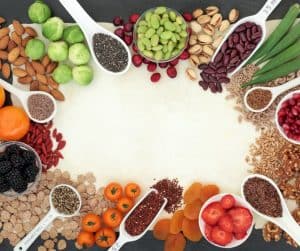
Iron and energy production are integral to sports performance. When it comes to physical performance, many female athletes find themselves caught between balancing dietary preferences and ensuring that iron intake is adequate. This is particularly the case for plant-based athletes or athletes with limited intake of red meat.
Intense physical exertion increases the body’s need for iron, and repeated sessions that deplete the body may lead to iron deficiency anaemia with inadequate iron intake or poor absorption. As previously mentioned, iron deficiency may contribute to exhaustion and will likely have an adverse effect on training and competition.
Iron is an essential mineral that plays a vital role in metabolism and the transportation of oxygen through your body. Up to 65% of the body’s iron is found in haemoglobin. Haemoglobin is the substance found in red blood cells that delivers oxygen from your lungs to your body tissues via your bloodstream. This means that low haemoglobin levels lead to decreased oxygen delivery to the body’s tissues, working muscles and organs.
Iron is also essential for the formation of myoglobin in muscle cells, a protein that carries and stores oxygen in muscle tissue. As oxygen is needed for aerobic metabolism, it’s easy to understand how low myoglobin (oxygen transportation around the muscles) impairs your aerobic function and ultimately, physical performance. It is also essential for brain health, physical growth and the synthesis of several hormones in your body. If you aren’t sure of the common signs of iron deficiency, you may like to read our previous blog here.
Put simply, if you are suffering from anaemia or are iron deficient your muscles will receive less oxygen and produce more lactic acid during training sessions, and your health and wellbeing will be severely compromised and could lead to serious health issues.
Energy production takes place in the mitochondria as part of the electron transport chain. In this process, a charged gradient is created across the membrane, which in turn drives the synthesis of energy as adenosine triphosphate (ATP). Both haem animal and plant-based forms of iron are important for the protein complexes within the electron transport chain.
Iron is found in mitochondria within skeletal muscles storing 10–15% of the body’s iron. Iron is particularly concentrated in type-1 slow-twitch muscle fibres. These fibres have high mitochondria concentrations, slow contraction rates and a reliance on aerobic metabolism and oxidative phosphorylation.
Endurance athletes typically have more slow twitch muscle fibres than type-2 fibres.
Vegetarian or plant-based athletes are at a much higher risk of iron deficiency and may need significantly more iron in their diet, due to the reduced bioavailability of iron from plant-based foods. Knowledge of sources of iron-rich foods and beneficial combinations of foods can be helpful. For example: pairing plant-based iron-rich foods with a source of vitamin C can increase iron absorption.
It is important to remember that your iron deficiency may have nothing to do with your iron intake and other physiological and environmental circumstances may be contributing to iron deficiency.
Tools such as our Anaemia Quiz may help to identify if you are at risk of iron deficiency or anaemia.
Want to know more? Contact the Athlete Sanctuary and learn how we can help.
About the Author: Kate Smyth is a Sports naturopath, nutritionist and female centric running coach. She is the founder of the Athlete Sanctuary- a holistic healthcare clinic for athletes of all levels and sporting codes. Kate has a thirst for knowledge with two bachelor’s and a master’s degree under her belt. She has been involved in sports for many decades and competed for Australia in the Commonwealth Games and Olympic Games marathons with a personal best time of 2 hours 28 minutes. For more information visit https://athletesanctuary.com.au/kate-smyth
References
Alaunyte I, Stojceska V, Plunkett A. (2015). Iron and the female athlete: a review of dietary treatment methods for improving iron status and exercise performance. J Int Soc Sports Nutr. 12. doi:10.1186/s12970-015-0099-2
Halas M. (2009): Special Considerations for Vegans and Vegetarians. The Plant-Based Boost Nutrition Solutions for Athletes and Exercise Enthusiasts. Middletown, DE: Super Kids Nutrition Incorporated.
Semenova, E. A., Miyamoto-Mikami, E., Akimov, E. B., Al-Khelaifi, F., Murakami, H., Zempo, H., … & Ahmetov, I. I. (2020). The association of HFE gene H63D polymorphism with endurance athlete status and aerobic capacity: novel findings and a meta-analysis. European Journal of Applied Physiology, 120(3), 665-673.
Stugiewicz, M., Tkaczyszyn, M., Kasztura, M., Banasiak, W., Ponikowski, P., & Jankowska, E. A. (2016). The influence of iron deficiency on the functioning of skeletal muscles: experimental evidence and clinical implications. European Journal of heart failure, 18(7), 762-773.

Kate Smyth is a sports naturopath, nutritionist and female-centric running coach. She is the founder of the Athlete Sanctuary – a holistic healthcare clinic for athletes of all levels and sporting codes.
Kate has a thirst for knowledge, with two bachelor’s and a master’s degree under her belt. She has been involved in sports for many decades and competed for Australia in the Commonwealth Games and Olympic Games marathons with a personal best time of 2 hours 28 minutes.
Targeted naturopathic care, nutrition and holistic coaching for active individuals.
Normatec Recovery systems- hire and purchase
Birregurra -28-30 Strachan Street,
Torquay- 20 Cantala Drive, Jan Juc
TELEHEALTH – Aus wide, New Zealand, Canada and globally (except US)
Melbourne and Ballarat clinics are currently online